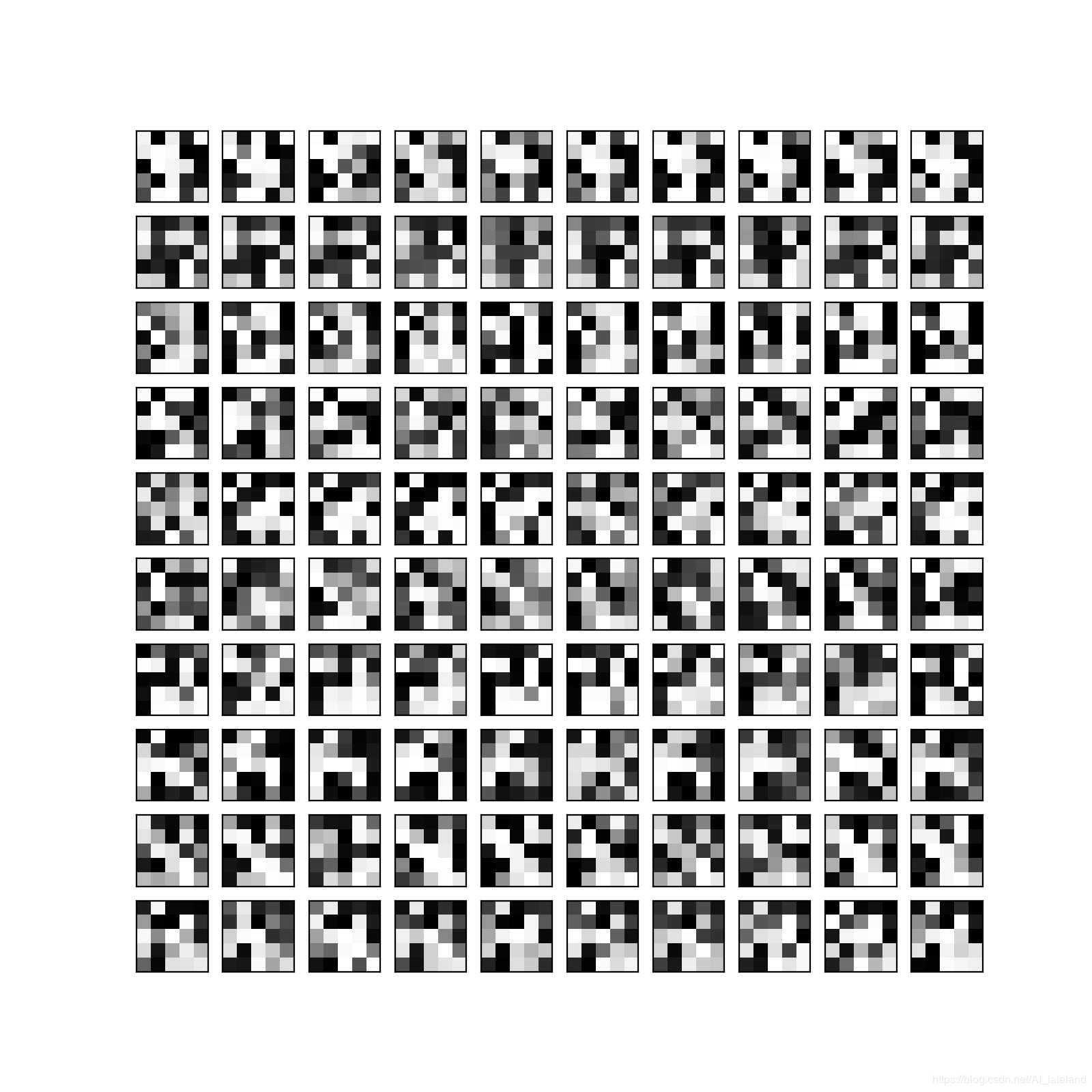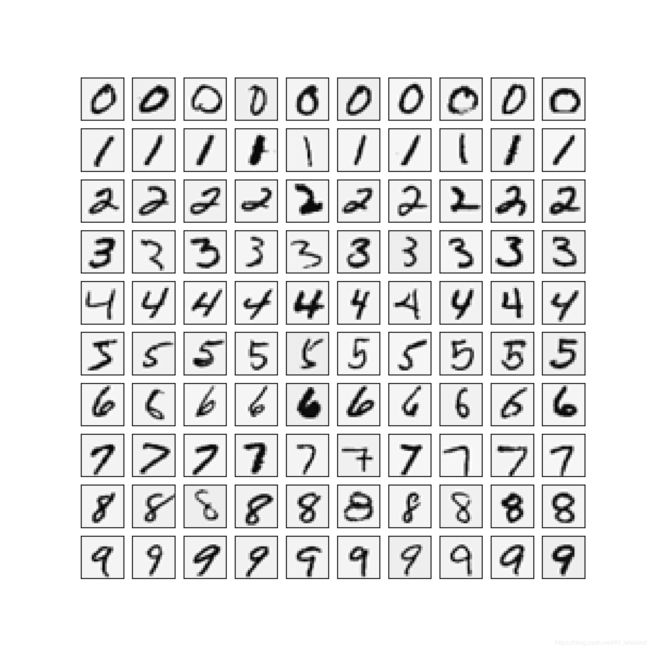吴恩达机器学习CS229A_EX3_LR与NN手写数字识别_Python3
任务描述
数据集为手写数字,是一个多分类问题,分别用逻辑回归和神经网络做。
逻辑回归
逻辑回归及其正则化已经在 EX 2 做过,这里做一些修改即可。
首先导入数据,给出的数据集是 Matlab 的 .mat 格式,每个样本是 20 * 20 的灰度图,共 5000 个样本:
import numpy as np
from scipy.io import loadmat
import scipy.optimize as opt
def loadData(filename):
return loadmat(filename)
data = loadmat('ex3data1.mat')
print(data['X'].shape, data['y'].shape)(5000, 400) (5000, 1)
Process finished with exit code 0接着对数据预处理 ,因为是数字 0 ~ 9 的多分类问题,需要 10 个分类器,这里 theta 初始化为大小为 11 * n+1 的数组,11 是因为数字 0 的标签是 10,这样后续程序写起来比较简洁。
def initData(data):
# 样本数
m = data['X'].shape[0]
# 特征数
n = data['X'].shape[1]
# 增加一列 bias
data['X'] = np.append(data['X'], np.ones(m).reshape(m,1), axis=1)
X = data['X']
y = data['y']
theta = np.zeros((11, n + 1))
return X, y, theta编写 Logistic Regression 需要的函数,详细内容可参考: 吴恩达机器学习CS229A_EX2_逻辑回归与正则化 。
这里根据要求对梯度求解函数做了改写,用矩阵运算替代循环,函数的计算结果和之前的是一样的。
def sigmoid(z):
return 1 / (1 + np.exp(-z))
def costReg(theta, X, y, lamda):
n = len(theta)
m = len(y)
first = -y * np.log(sigmoid(X @ theta.reshape(n,1)))
second = -(1 - y) * np.log(1 - sigmoid(X @ theta.reshape(n,1)))
reg = (lamda / (2 * m)) * np.sum(np.power(theta.reshape(n,1), 2))
return (sum(first + second) / m) + reg
def gradientReg_noLoop(theta, X, y, lamda):
n = len(theta)
m = len(y)
error = sigmoid(X @ theta.reshape(n, 1)) - y
grad = (X.T @ error / m) + ((lamda / m) * theta.reshape(n, 1))
grad[0][0] = np.sum(error * X[:, 0].reshape(m, 1)) / m
grad = np.reshape(grad, (n,))
return grad编写分类函数和测试函数:
# 分类函数
def one_vs_all(theta, X, y, lamda):
m = len(y)
n = len(theta[0])
# 从 1 到 10 总共训练 10 个分类器,依次保存到 theta
for i in range(1, 11):
# label 为 i 置 1,不为 i 置 0
y_i = np.array([1 if label == i else 0 for label in y])
y_i = np.reshape(y_i,(m, 1))
theta_i = theta[i,:]
theta_i = np.reshape(theta_i,(n, 1))
# 使用 scipy 的库函数就算最优参数
result = opt.fmin_tnc(func=costReg, x0=theta_i, fprime=gradientReg_noLoop, args=(X, y_i, lamda))
# 保存第 i 个分类器
theta[i,:] = result[0]
# 测试函数
def predict_all(theta, X, y):
m = len(y)
y_pre = np.zeros((m, 2))
# term 为 m * 10 的数组,每一行依次记录该样本为 1,2,……,9,0 的概率
term = sigmoid(X @ theta.T)
# 选取最大概率对应的 label 作为预测结果
for sample in range(m):
for i in range(1, 11):
if(term[sample][i] > y_pre[sample][1]):
y_pre[sample][0] = i
y_pre[sample][1] = term[sample][i]
rate = 0.0
for sample in range(m):
if(y_pre[sample][0] == y[sample]):
rate += 1
rate = (rate / m) * 100
print('accuracy = {0}%'.format(rate))执行并测试,可以看到这里不做正则化限制效果更好 :
data = loadData('ex3data1.mat')
X, y, theta = initData(data)
one_vs_all(theta, X, y, 0)
predict_all(theta, X, y)accuracy = 97.36%
Process finished with exit code 0data = loadData('ex3data1.mat')
X, y, theta = initData(data)
one_vs_all(theta, X, y, 0.1)
predict_all(theta, X, y)accuracy = 96.5%
Process finished with exit code 0data = loadData('ex3data1.mat')
X, y, theta = initData(data)
one_vs_all(theta, X, y, 1)
predict_all(theta, X, y)accuracy = 94.39999999999999%
Process finished with exit code 0完整程序:
import numpy as np
from scipy.io import loadmat
import scipy.optimize as opt
def loadData(filename):
return loadmat(filename)
def initData(data):
# 样本数
m = data['X'].shape[0]
# 特征数
n = data['X'].shape[1]
# 增加一列 bias
data['X'] = np.append(data['X'], np.ones(m).reshape(m,1), axis=1)
X = data['X']
y = data['y']
theta = np.zeros((11, n + 1))
return X, y, theta
def sigmoid(z):
return 1 / (1 + np.exp(-z))
def costReg(theta, X, y, lamda):
n = len(theta)
m = len(y)
first = -y * np.log(sigmoid(X @ theta.reshape(n,1)))
second = -(1 - y) * np.log(1 - sigmoid(X @ theta.reshape(n,1)))
reg = (lamda / (2 * m)) * np.sum(np.power(theta.reshape(n,1), 2))
return (sum(first + second) / m) + reg
def gradientReg_noLoop(theta, X, y, lamda):
n = len(theta)
m = len(y)
error = sigmoid(X @ theta.reshape(n, 1)) - y
grad = (X.T @ error / m) + ((lamda / m) * theta.reshape(n, 1))
grad[0][0] = np.sum(error * X[:, 0].reshape(m, 1)) / m
grad = np.reshape(grad, (n,))
return grad
# 分类函数
def one_vs_all(theta, X, y, lamda):
m = len(y)
n = len(theta[0])
# 从 1 到 10 总共训练 10 个分类器,依次保存到 theta
for i in range(1, 11):
# label 为 i 置 1,不为 i 置 0
y_i = np.array([1 if label == i else 0 for label in y])
y_i = np.reshape(y_i,(m, 1))
theta_i = theta[i,:]
theta_i = np.reshape(theta_i,(n, 1))
# 使用 scipy 的库函数就算最优参数
result = opt.fmin_tnc(func=costReg, x0=theta_i, fprime=gradientReg_noLoop, args=(X, y_i, lamda))
# 保存第 i 个分类器
theta[i,:] = result[0]
# 测试函数
def predict_all(theta, X, y):
m = len(y)
y_pre = np.zeros((m, 2))
# term 为 m * 10 的数组,每一行依次记录该样本为 1,2,……,9,0 的概率
term = sigmoid(X @ theta.T)
# 选取最大概率对应的 label 作为预测结果
for sample in range(m):
for i in range(1, 11):
if(term[sample][i] > y_pre[sample][1]):
y_pre[sample][0] = i
y_pre[sample][1] = term[sample][i]
rate = 0.0
for sample in range(m):
if(y_pre[sample][0] == y[sample]):
rate += 1
rate = (rate / m) * 100
print('accuracy = {0}%'.format(rate))
data = loadData('ex3data1.mat')
X, y, theta = initData(data)
one_vs_all(theta, X, y, 0)
predict_all(theta, X, y)
神经网络
这里神经网络的参数已经给出,不需要进行训练(下一个 EX 做),我们只需要编程写出神经网络的结构,执行分类就行。
导入并初始化数据:
import numpy as np
import matplotlib
import matplotlib.pyplot as plt
from scipy.io import loadmat
def loadData(filename):
return loadmat(filename)
def initData(data):
X = data['X']
# X : 增加一列 bias(要增加到第一列)
X = np.insert(X, 0, values=np.ones(X.shape[0]), axis=1)
y = data['y']
return X, y
data = loadData('ex3data1.mat')
X, y = initData(data)
print(X.shape, y.shape)
theta = loadData('ex3weights.mat')
theta1 = theta['Theta1']
theta2 = theta['Theta2']
print(theta1.shape, theta2.shape)(5000, 401) (5000, 1)
(25, 401) (10, 26)
Process finished with exit code 0
根据神经网络的结构(一层输入层 400+1 ,一层隐藏层 25+1 ,一层输出层 10),计算结果:
def sigmoid(z):
return 1 / (1 + np.exp(-z))
def NN(X, theta1, theta2):
hidden_layer = sigmoid(X @ theta1.T)
hidden_layer = np.insert(hidden_layer, 0, values=np.ones(X.shape[0]), axis=1)
output = sigmoid(hidden_layer @ theta2.T)
return output测试结果,正确率 97.52% :
def predict(output, y):
m = len(y)
rate = 0.0
for sample in range(m):
pre_res = -1
pre_pro = 0.0
for i in range(10):
if(output[sample][i] > pre_pro):
pre_res = i + 1
pre_pro = output[sample][i]
if(pre_res == y[sample]):
rate += 1
print(pre_res)
rate = (rate / m) * 100
print('accuracy = {0}%'.format(rate))
data = loadData('ex3data1.mat')
X, y = initData(data)
theta = loadData('ex3weights.mat')
theta1 = theta['Theta1']
theta2 = theta['Theta2']
output = NN(X, theta1, theta2)
predict(output, y)accuracy = 97.52%
Process finished with exit code 0这里笔者试着可视化隐藏层,看看能否观察出什么:
找了 100 个样本,在对应位置打印它们在隐藏层的 5*5 的图像:
果然并不能观察出什么。。。
完整程序:
import numpy as np
import matplotlib
import matplotlib.pyplot as plt
from scipy.io import loadmat
def loadData(filename):
return loadmat(filename)
def initData(data):
X = data['X']
# X : 增加一列 bias(要增加到第一列)
X = np.insert(X, 0, values=np.ones(X.shape[0]), axis=1)
y = data['y']
return X, y
def sigmoid(z):
return 1 / (1 + np.exp(-z))
def NN(X, theta1, theta2):
hidden_layer = sigmoid(X @ theta1.T)
hidden_layer = np.insert(hidden_layer, 0, values=np.ones(X.shape[0]), axis=1)
output = sigmoid(hidden_layer @ theta2.T)
return output
def predict(output, y):
m = len(y)
rate = 0.0
for sample in range(m):
pre_res = -1
pre_pro = 0.0
for i in range(10):
if(output[sample][i] > pre_pro):
pre_res = i + 1
pre_pro = output[sample][i]
if(pre_res == y[sample]):
rate += 1
print(pre_res)
rate = (rate / m) * 100
print('accuracy = {0}%'.format(rate))
def visualizing(layer):
sample_idx = range(0,5000,50)
sample_images = layer[sample_idx, :]
fig, ax_array = plt.subplots(nrows=10, ncols=10, sharey=True, sharex=True, figsize=(8, 8))
for r in range(10):
for c in range(10):
ax_array[r, c].matshow(sample_images[10 * r + c].reshape((5, 5)).T,cmap=matplotlib.cm.binary)
plt.xticks(np.array([]))
plt.yticks(np.array([]))
plt.show()
data = loadData('ex3data1.mat')
X, y = initData(data)
theta = loadData('ex3weights.mat')
theta1 = theta['Theta1']
theta2 = theta['Theta2']
output = NN(X, theta1, theta2)
predict(output, y)

